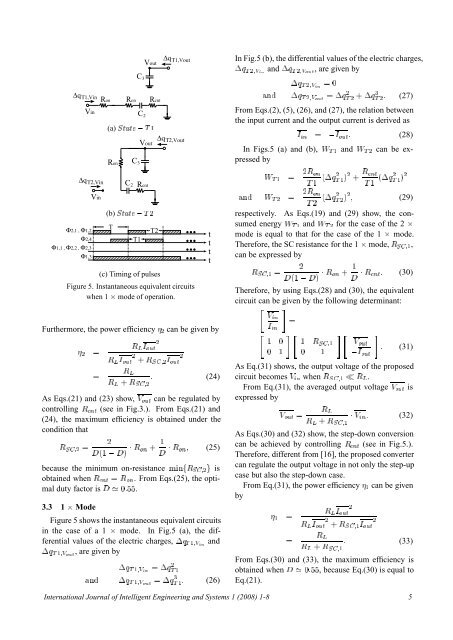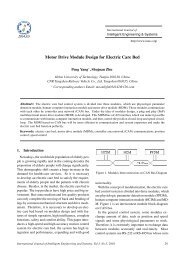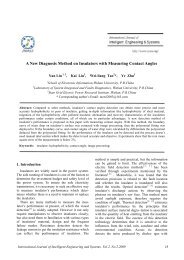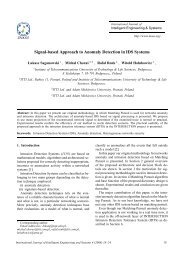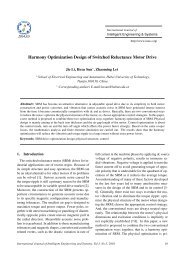IJIES-2008 VOLUME 1 ISSUE 1 - inass
IJIES-2008 VOLUME 1 ISSUE 1 - inass
IJIES-2008 VOLUME 1 ISSUE 1 - inass
You also want an ePaper? Increase the reach of your titles
YUMPU automatically turns print PDFs into web optimized ePapers that Google loves.
Furthermore, the power efficiency ¾ can be given byAs Eqs.(21) and (23) show, Î ÓÙØ can be regulated bycontrolling Ê ÒØ (see in Fig.3.). From Eqs.(21) and(24), the maximum efficiency is obtained under thecondition thatbecause the minimum on-resistance ÑÒÊ Ë¾ isobtained when Ê ÒØ Ê ÓÒ . From Eqs.(25), the optimalduty factor is ³ ¼.Δq Τ1,VoutIn Fig.5 (b), the differential values of the electric charges,Vout¡Õ Ì ¾ÎÒ and ¡Õ Ì ¾ÎÓÙØ , are given byC 3¡Õ Ì ¾ÎÒ ¼Δq Τ1,VinÒ ¡ÕRon Ron RcntÌ ¾ÎÓÙØ ¡ÕÌ ¾ ¾ ·¡Õ¿ Ì ¾ (27)VinCFrom Eqs.(2), (5), (26), and (27), the relation between2the input current and the output current is derived as(a) ËØØ Ì ½Δq Á Ò Á ÓÙØ (28)Τ2,VoutVoutIn Figs.5 (a) and (b), Ï Ì ½ and Ï Ì ¾ can be expressedbyRon C 3Δq Ï ¾Ê ÓÒΤ2,VinÌ ½ C 2 RcntÌ ½ ´¡Õ¾ Ì ½ µ¾ · ÊÒØÌ ½ ´¡Õ¾ Ì ½ µ¾VinÒ Ï ¾Ê ÓÒÌ ¾ Ì ¾ ´¡Õ¾ Ì ¾ µ¾ (29)(b) ËØØ Ì ¾respectively. As Eqs.(19) and (29) show, the consumedenergy Ï Ì ½ and Ï Ì ¾ for the case of the 2 ¢TΦ2,1 , Φ1,2T2t mode is equal to that for the case of the 1 ¢ mode.Φ2,4T1t Therefore, the SC resistance for the 1 ¢ mode, ÊΦ1,1 , Φ2,2 , Φ2,3˽ ,tΦ1,3can be expressed byt¾(c) Timing of pulsesÊ Ë½ ¡ Ê ÓÒ · ½´½ µ ¡ Ê ÒØ (30)Figure 5. Instantaneous equivalent circuitsTherefore, by using Eqs.(28) and (30), the equivalentwhen 1 ¢ mode of operation.circuit can be given by the following determinant: ÎÒÁ Ò ¾½ ¼ ½ ÊÊ Ä Á ˽ ÎÓÙØÓÙØ (31) ¾ ¼ ½ ¼ ½ Á¾ ¾ÓÙØÊ Ä Á ÓÙØ · Ê˾ Á ÓÙØAs Eq.(31) shows, the output voltage of the proposedÊ Ä (24) circuit becomes Î Ò when Ê Ë½ Ê Ä .Ê Ä · Ê Ë¾From Eq.(31), the averaged output voltage Î ÓÙØ isexpressed byÊ ÄÎ ÓÙØ ¡ Î Ò (32)Ê Ä · Ê Ë½As Eqs.(30) and (32) show, the step-down conversion¾Ê ˾ ¡ Ê ÓÒ · ½´½ µ ¡ Ê ÓÒ (25)can be achieved by controlling Ê ÒØ (see in Fig.5.).Therefore, different from [16], the proposed convertercan regulate the output voltage in not only the step-upcase but also the step-down case.From Eq.(31), the power efficiency ½ can be givenby¾Ê Ä Á ÓÙØ ½ ¾ ¾Ê Ä Á ÓÙØ · Ê˽ Á ÓÙØIn Fig.5 (a), the dif-Ê Äand (33)Ê Ä · Ê Ë½From Eqs.(30) and (33), the maximum efficiency is¡Õ Ì ½ÎÒ ¡ÕÌ ¾ ½Ò ¡Õ Ì ½ÎÓÙØ ¡Õ Ì ¿ ½ (26)3.3 1 ¢ ModeFigure 5 shows the instantaneous equivalent circuitsin the case of a 1 ¢ mode.ferential values of the electric charges, ¡Õ Ì ½ÎÒ¡Õ Ì ½ÎÓÙØ , are given byobtained when ³ ¼, because Eq.(30) is equal toEq.(21).International Journal of Intelligent Engineering and Systems 1 (<strong>2008</strong>) 1-8 5


